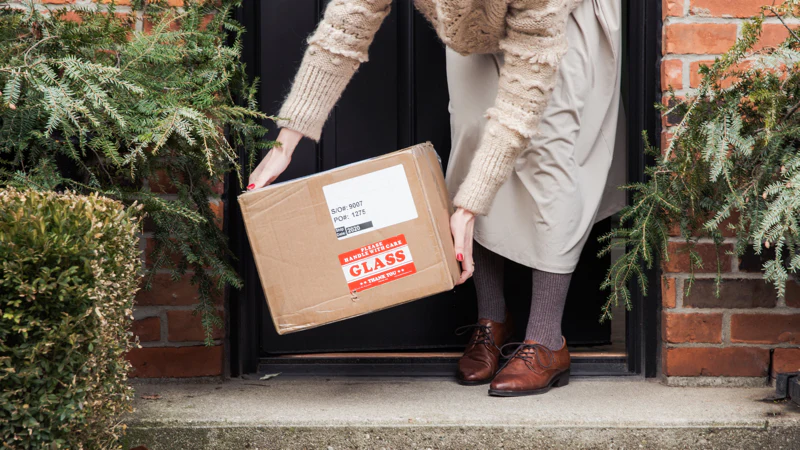Blog Topics
Last FootLeaders Solving the Last Foot of the Supply Chain

Theft, weather-damaged goods, spoiled perishables. These are just a few of the problems Americans are experiencing with their daily deliveries, as retailers and logistics companies scurry to meet the meteoric demand in e-commerce.
As a result, many consumers are left with the unsettling feelings of worry, inconvenience, and hassle associated with managing their deliveries. Online retailers suffer the brunt of the cost of damaged and stolen goods, as they tend to replace them. And delivery companies are left with a black eye on their brand, as they’re the ones putting the packages on the front porch.
Collectively, these problems are associated with what we’ve coined the Last Foot of the supply chain. They occur on the front porch at homes, the drop-off places in large apartment complexes, the front doors in strip malls. Wherever packages, food, prescriptions, and other goods are being delivered--this is the Last Foot of the supply chain.
It will take a number of leaders on several fronts to start tackling the problems of the Last Foot and, no doubt, many years. So who are the current leaders stepping up to solve the problems of the Last Foot?
We take a closer look here at the people and the organizations that are starting to make a difference. This includes:
- Industry thought leaders
- Media - Consumer Awareness
- Large Industry Players -- Retailers, Shippers, Delivery Companies
- Solution Providers
- Research Leaders
- Lawmakers
- Law Enforcement

Industry thought leaders
On the front line of any dramatic shift in the way things are done are those that champion and foster ideas ahead of the curve. Here are a few key leaders in the supply chain space speaking at conferences, doing research, and writing key pieces to impact change.
Ben Stickle
Dr. Ben Stickle, Associate Professor of Criminal Justice at Middle Tennessee State University, is a recognized expert and industry forerunner addressing loss in the last mile delivery, focusing on package theft. He has appeared on several national talk shows, including Good Morning America, as an expert weighing in on the problem of porch piracy.
Stickle has presented at several Last Mile or delivery-related conferences. He has written several significant research papers on package theft, including a key piece that introduces the problems of the Last Foot, The Last Foot of the Supply Chain is Presenting New Challenges.
“The problems at the Last Foot are perhaps the most costly of the entire supply chain,” says Stickle. “Police, governments, and legislators will be unlikely to have an impact. Rather, consumers, retailers, and delivery providers must work together to solve this issue.”
Check out some of Stickle’s other key works on package theft here.
John Callan
John Callan is the CEO of Ursa Major Associates with 20+ years of experience in logistics and parcel delivery. His company provides strategy consulting and business development services in the areas of postal, parcel, and express logistics.
Callan has spoken and/or is set to speak at several logistics conferences, including Parcel Forum 21. Most recently, Callan has focused on what he calls Door Wars, which is similar in focus to the problems of Last Foot.
“I think there’s a missing link in there when the consumer actually has the goods in their hands and the merchant knows that,” says Callan. “I think the answer is every parcel has a barcode and optical scanning. … There should be a scan at every point.”
Callan believes the lack of communication/notification along the delivery supply chain is a key issue. In fact, most merchants don’t know if their goods have made it to the customer or not.
“If the delivery has been made, it seems that the merchant ought to know that,” Callan said.
The same goes for the shipper.
“Amazon will take a picture of it to show you it’s at the door,” Callan said. “But you don’t know if someone actually received the package.”
Penelope Register-Shaw
As a former leader in logistics for Amazon, FedEx and Walmart, Penelope Register-Shaw has a breadth of experience and insights around last mile delivery. Currently, she is the Chief Strategy Officer for FrontDoor Collective, the first micro-last mile delivery network with the capacity to cover 90% of residences and businesses in the U.S. and Canada.
Register-Shaw has been a speaker at several Last Mile-related conferences, most recently on a panel at Home Delivery World, discussing how e-commerce has changed the potential for new customers. In looking at the supply chain, she believes that the focus has been on all aspects except for the Last Foot.
“Many of the problems in the supply and value chains supporting online purchases, such as tracking and notifications, scheduled delivery, and same day delivery, have been improved to the point that they are standard features rather than exceptions,” she said. “The same cannot be said for the problems of the last foot.”
And despite massive investment in getting goods to the door, Register-Shaw points out the risk of all of that effort going bad at the door.
“Still for a few hours more, things can, and do, go wrong--packages get rained on, additional items are stacked in such a way that packaging or contents are damaged or porch pirates appear and disappear,” she said. “The careful investments that retailers, fulfillment services, and delivery companies have made to create trust is destroyed in a flash, and the finger pointing about whose responsibility it is to fix the problem begins.”
You can learn more about Register-Shaw and follow her posts here on LinkedIn.
Adoorn Founders
Adoorn founders Adam Schumacher and Mike Vig recognized that the rise in e-commerce and changes in buyer behaviors were dramatically increasing the problems at the porch. To solve these issues, they invented a lockable delivery box that is currently being sold to consumers.
Knowing there’s a big gap in what consumers and businesses understand about Last Foot issues, they’ve been actively educating through their blog and working with other thought leaders in the space.
”We definitely have a long way to go in order to solve all of the "Last Foot" issues that exist,” Vig said. “Most importantly, consumers need a convenient way to guarantee they get what they pay for when purchasing online. An easy-to-use lockable parcel box is a great solution to address many of these issues.”
Although it’s the early stages for their solution, Adoorn is in it for the long haul, believing their delivery box is the best way to solve the problems consumers face.
“We are committed to solving the "last foot" of the supply chain as we work to make sure everyone is able to experience the same peace of mind knowing what they order is safe, fresh, and where it is supposed to be,” Vig said.
Media
Porch pirates are a hot topic around the news and social media. No doubt, we will see many reports and posts this coming Holiday season. In fact, Google Trends shows a major uptick in searches for porch pirates during November and December.
Much of the reports have been driven by local news in cities with specific cases. Typically, someone catches a porch pirate on video. Here’s a perfect example of this in Charleston, SC, when a porch pirate was caught right after an Amazon package was delivered.
But package theft has caught the attention of the national media, as well. Recently, Good Morning America did a segment on it. And there are several consumer tips videos out there, like this one from Fox News.
As far as social media, there are a multitude of posts from victims of package theft on Twitter and Reddit. And Mark Rober, maker of Glitter Bomb, has had several viral videos on YouTube getting back at porch pirates.
Collectively, the news and social media have served to make Americans very aware of the problems of package theft. The more we see a bubbling up of the problem from news and social media, the more demand there will be for change.
Large Industry Players
We know the key players are delivery/logistics companies like Amazon, UPS, FedEx, as well as, the United States Postal Services (USPS). They haven’t specifically addressed the front porch, but there are several alternative ways they offer to receive packages. Much of their focus has been on “lockers” and “hubs”.
For these solutions, people go to a local center to pick up their packages on their own. In addition, large grocery stores, as well as other big merchandise chains, have curbside pickup as an alternative way to receive groceries and goods.
Research Leaders
To understand big questions like the prevalence of porch theft, where it occurs, and who are the victims, there are a few research leaders that have provided valuable data. C+R Research published this important 2020 report on package theft statistics that often gets cited.
Also, the leading academic researcher on package theft is Dr. Stickle, who has published several studies. He, along with the team at Adoorn, has categorized issues around the porch as the Last Foot of the supply chain. A key piece on this concept can be found here.
Beyond this, the Adoorn blog is perhaps the most complete set of articles and angles covering problems of the porch. It covers package theft, food delivery, and business delivery. Its key piece is the 2021 Report on Package Theft in America.
Front Porch Solution Providers
Package delivery boxes like the Adoorn are the easiest and most advantageous choice when it comes to safe delivery storage. To some extent, security doorbell cameras like Ring and other security cameras can deter package theft. But the reality is that Americans will need to evolve to using the lockable package box, or the modern mailbox, in order to have the convenience they want in receiving packages any time of the day.
Lawmakers & Law Enforcement
Porch theft is a crime, but very rarely are culprits caught in the act. In addition, the police don’t have a category for it when filling out reports. As a result, there is not significant crime data to understand where and when porch piracy is committed other than through research surveys and polls.
Currently, the federal government has not created any parcel laws to act as a deterrent. However, several states are now upping the punishment for the crime and more. See what five states are doing here.
Beyond this, the local police have begun to set up traps in key areas with a lot of theft to see if they can nab porch pirates. In fact, YouTube and Twitter have several videos posted by police departments to, hopefully, act as a deterrent.
Conclusion
Although it’s still the early days of bringing to light the problems of the Last Foot, there are several leaders making an impact across a number of areas. Collectively, momentum is being built to solve these issues.

